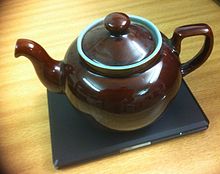Hyper Text Coffee Pot Control Protocol: Difference between revisions
No edit summary |
No edit summary |
||
| Line 10: | Line 10: | ||
On April 1, 2014, RFC 7168 extended HTCPCP to fully handle teapots.<ref name=rfc7168 /> |
On April 1, 2014, RFC 7168 extended HTCPCP to fully handle teapots.<ref name=rfc7168 /> |
||
There are also makers that rigged actual coffee or tea pots with HTCPCP-compatible control interface, either in a humorous but simple way, or in a functional [[Internet of Things]] way.{{Citation needed|date=April 2016}} One example of a functional way is the |
There are also makers that rigged actual coffee or tea pots with HTCPCP-compatible control interface, either in a humorous but simple way, or in a functional [[Internet of Things]] way.{{Citation needed|date=April 2016}} One example of a functional way is the [https://www.myappkettle.com/ AppKettle]. |
||
==Commands and replies== |
==Commands and replies== |
||
Revision as of 09:33, 17 July 2017


The Hyper Text Coffee Pot Control Protocol (HTCPCP) is a facetious communications protocol for controlling, monitoring, and diagnosing coffee pots. It is specified in RFC 2324, published on 1 April 1998 as an April Fools' Day RFC,[2] as part of an April Fools prank.[3] An extension, HTCPCP-TEA, was published as RFC 7168 on 1 April 2014[4] to support brewing teas, which is also an April Fools' Day RFC.
Protocol
RFC 2324 was written by Larry Masinter, who describes it as a satire, saying "This has a serious purpose – it identifies many of the ways in which HTTP has been extended inappropriately."[5] The wording of the protocol made it clear that it was not entirely serious; for example, it notes that "there is a strong, dark, rich requirement for a protocol designed espressoly [sic] for the brewing of coffee".
Despite the joking nature of its origins, or perhaps because of it, the protocol has remained as a minor presence online. The editor Emacs includes a fully functional client side implementation of it,[6] and a number of bug reports exist complaining about Mozilla’s lack of support for the protocol.[7] Ten years after the publication of HTCPCP, the Web-Controlled Coffee Consortium (WC3) published a first draft of "HTCPCP Vocabulary in RDF"[8] in parody of the World Wide Web Consortium's (W3C) "HTTP Vocabulary in RDF".[9]
On April 1, 2014, RFC 7168 extended HTCPCP to fully handle teapots.[4]
There are also makers that rigged actual coffee or tea pots with HTCPCP-compatible control interface, either in a humorous but simple way, or in a functional Internet of Things way.[citation needed] One example of a functional way is the AppKettle.
Commands and replies
HTCPCP is an extension of HTTP. HTCPCP requests are identified with the uniform resource identifier (URI) scheme coffee (or the corresponding word in any other of the 29 listed languages) and contain several additions to the HTTP methods:
BREW or POST |
Causes the HTCPCP server to brew coffee. Using POST for this purpose is deprecated. A new HTTP Request header field "Accept-Additions" is proposed, supporting optional additions including Cream, Whole-milk, Vanilla, Raspberry, Whisky, Aquavit, etc. |
GET |
"Retrieves" coffee from the HTCPCP server. |
PROPFIND |
Returns metadata about the coffee. |
WHEN |
Says "when", causing the HTCPCP server to stop pouring milk into the coffee (if applicable). |
It also defines two error responses:
406 Not Acceptable |
The HTCPCP server is unable to provide the requested addition for some reason; the response should indicate a list of available additions. The RFC observes that "In practice, most automated coffee pots cannot currently provide additions." |
418 I'm a teapot |
The HTCPCP server is a teapot; the resulting entity body "may be short and stout" (a reference to the song "I'm a Little Teapot"). Demonstrations of this behaviour exist.[1][10] |
See also
References
- ^ a b Reddington, Joseph, Illustrated implementation of Error 418
{{citation}}: Cite has empty unknown parameter:|1=(help) - ^ "Request for Comments 2324", Network Working Group, IETF
- ^ DeNardis, Laura (30 September 2009). Protocol Politics: The Globalization of Internet Governance. MIT Press. pp. 27ff. ISBN 978-0-262-04257-4. Retrieved 8 May 2012.
- ^ a b "Request for Comments 7168", The Hyper Text Coffee Pot Control Protocol for Tea Efflux Appliances (HTCPCP-TEA), IETF
- ^ Larry Masinter. "IETF RFCs". Archived from the original on 2013-04-11.
{{cite web}}: Unknown parameter|deadurl=ignored (|url-status=suggested) (help) - ^ "Emacs extension: coffee.el", Emarsden, Chez.
- ^ "Bug 46647 – (coffeehandler) HTCPCP not supported (RFC2324)", Bugzilla, Mozilla
- ^ HTCPCP Vocabulary in RDF – WC3 RFC Draft, Chief Arabica (Web-Controlled Coffee Consortium), 1 April 2008, retrieved 27 April 2017
- ^ Koch, Johannes (ed.), HTTP Vocabulary in RDF, et al, W3, retrieved 17 August 2009
- ^ A Goblin Teasmade teamaker with an implementation of Error 418
